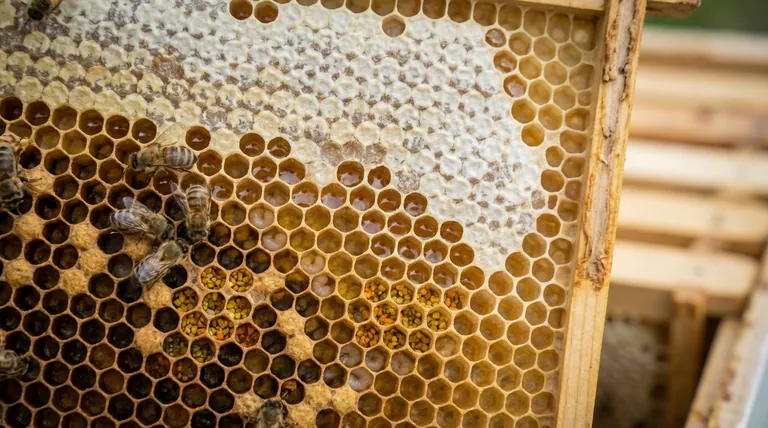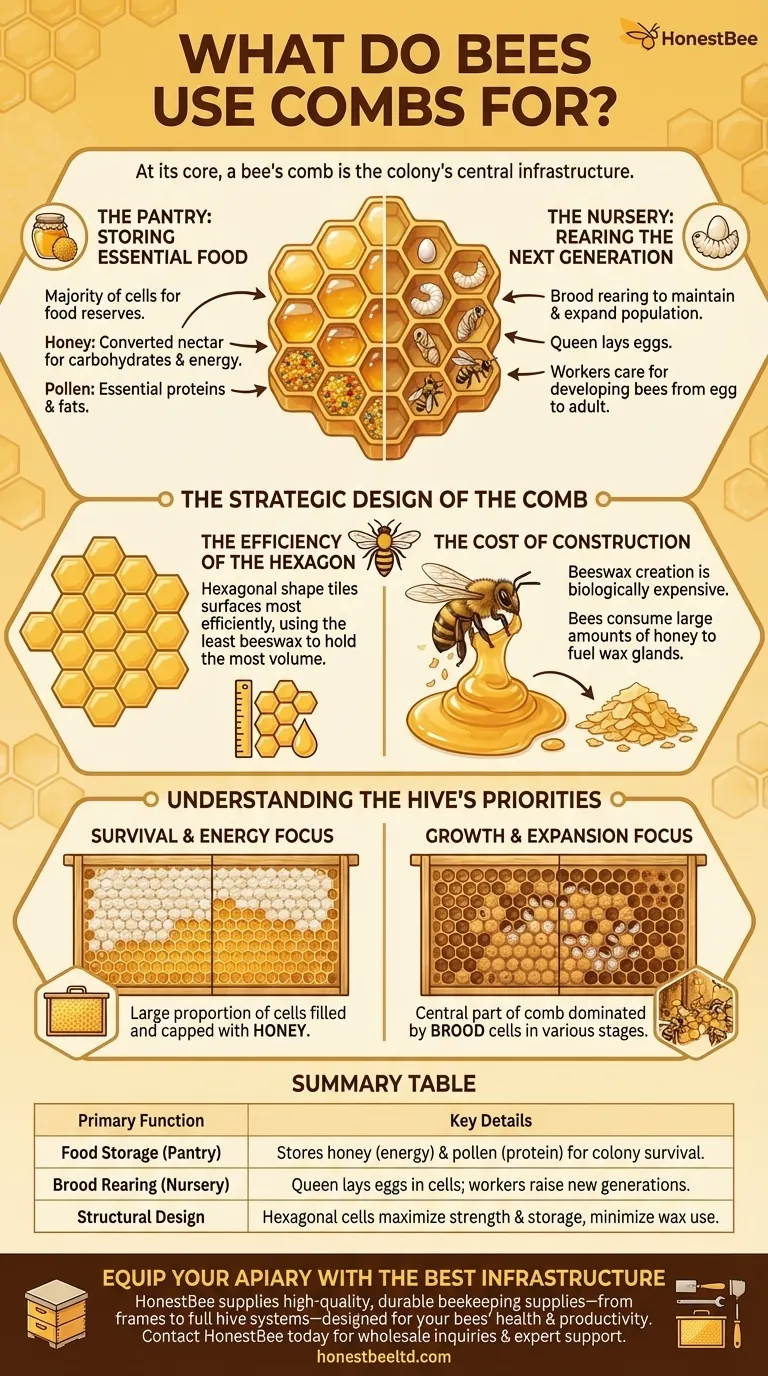At its core, a bee's comb is the colony's central infrastructure. It is a multi-purpose structure made of beeswax, primarily used for storing food and for raising the next generation of bees. Each comb is made of thousands of individual hexagonal cells that function like rooms within the hive.
The honeycomb is not merely for storage; it is the very heart of the colony, serving simultaneously as a pantry for food and a nursery for brood. Its design and function are absolutely critical to the hive's survival and growth.

The Comb as the Colony's Foundation
A beehive cannot function without its comb. This internal structure, meticulously built by worker bees from beeswax, provides the organized space necessary for every vital activity the colony undertakes.
The Pantry: Storing Essential Food
Bees use the majority of the comb's cells for storing food reserves. This ensures the colony can survive through winter or periods when nectar is scarce.
The cells are filled with two primary types of food: honey, which is converted nectar and serves as the bees' primary carbohydrate and energy source, and pollen, which provides essential proteins and fats.
The Nursery: Rearing the Next Generation
A significant portion of the comb is dedicated to what is called brood rearing. This is the process of raising new bees to maintain and expand the colony's population.
The queen bee lays a single egg in each designated cell. Worker bees then care for the egg as it develops through its life stages from larva to pupa, eventually emerging as an adult bee. These cells effectively serve as the hive's nursery.
The Strategic Design of the Comb
The structure of the honeycomb is a masterpiece of natural engineering. Its design is not arbitrary but is optimized for strength, space, and the efficient use of resources.
The Efficiency of the Hexagon
Bees build their comb cells in a hexagonal shape. This is the most efficient shape for tiling a surface, as it uses the least amount of material (beeswax) to hold the most volume.
This geometric precision ensures maximum storage capacity and structural integrity while minimizing the energy bees must expend to produce the wax.
The Cost of Construction
Creating beeswax is a biologically expensive process for bees. They must consume large amounts of honey to fuel the wax glands that secrete the tiny flakes of wax used for building.
Because of this high energy cost, the efficiency of the hexagonal design is paramount to the colony's overall resource management.
Understanding the Hive's Priorities
By observing a comb, you can understand the colony's current focus. The allocation of cells reveals the immediate needs and long-term strategy of the hive.
- If the primary focus is survival and energy: You will see a large proportion of cells filled and capped with honey.
- If the primary focus is growth and expansion: You will find the central part of the comb dominated by brood cells in various stages of development.
Ultimately, the honeycomb is the physical manifestation of the bee colony's life, work, and future.
Summary Table:
| Primary Function | Key Details |
|---|---|
| Food Storage (Pantry) | Stores honey (energy) and pollen (protein) for colony survival. |
| Brood Rearing (Nursery) | Queen lays eggs in cells; worker bees raise new generations of bees. |
| Structural Design | Hexagonal cells maximize strength and storage while minimizing wax use. |
Equip Your Apiary with the Best Infrastructure
The honeycomb is the foundation of a thriving hive. Ensure your commercial operation or distribution business has the same level of reliable support. HONESTBEE supplies high-quality, durable beekeeping supplies and equipment—from frames to full hive systems—designed to support the health and productivity of your bees.
Let us help you build a stronger operation. Contact HONESTBEE today for wholesale inquiries and expert support.
Visual Guide

Related Products
- Heavy Duty Stainless Steel Honeycomb Cutter
- Wooden Bee Brush with Triple Row Artificial Fiber for Beekeeping
- Wooden Bee Brush with Double-Row Horsehair Bristles
- Electric Honey Press Machine for Squeezing Honey Comb Press Equipment
- Electric Flatting and Embossing Machine with Tray for Beekeeping
People Also Ask
- What qualities are important for someone starting in beekeeping? Build a Thriving Apiary with the Right Mindset
- What is the basic principle of the honey extractor? Harness Centrifugal Force for Efficient Harvesting
- Why is it important to use clean wax for candle making? Ensure a Clean, Even Burn
- When can new beekeepers expect to harvest honey? A Guide to Your First Successful Harvest
- What are the uses of honey in various industries? Unlock Its Functional Power in Food, Pharma & Cosmetics



















